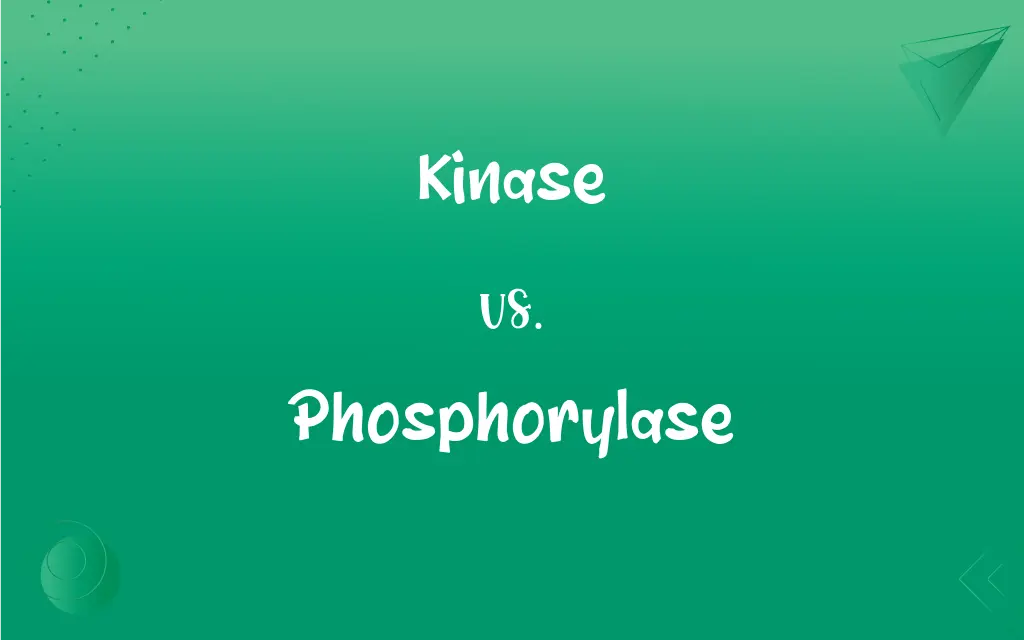Kinase vs. Phosphorylase: What's the Difference?
Edited by Aimie Carlson || By Harlon Moss || Updated on October 29, 2023
Kinase transfers phosphate groups to substrates, while phosphorylase adds phosphate groups to break down substrates.

Key Differences
Kinase and phosphorylase both involve phosphate groups in their actions. Kinases transfer phosphate groups from high-energy molecules like ATP to specific substrates, modifying their function. Phosphorylases, on the other hand, typically add phosphate groups to break down complex molecules, such as glycogen in glycogenolysis.
The role of kinases is diverse and crucial in signal transduction and cell regulation. They activate or deactivate proteins, influencing various cellular processes. Phosphorylases have a more specific function, mainly involved in catabolic reactions, breaking down molecules for energy production.
Kinases require a source of phosphate, often ATP, to carry out their function. They play a role in many cellular pathways, including cell growth and apoptosis. Phosphorylases are usually involved in energy metabolism, catalyzing reactions that release glucose or other simple sugars from larger carbohydrate stores.
Kinases are integral in the regulation of the cell cycle, with malfunctions often linked to cancer. They are targets for many pharmaceutical drugs. Phosphorylases, while crucial in metabolism, are less commonly targeted for drug development, but their dysfunction can lead to metabolic disorders.
Both kinase and phosphorylase are enzymes, but their specificity and mechanisms of action differ. Kinases are involved in phosphorylation, a key regulatory mechanism, whereas phosphorylases are primarily involved in energy mobilization through catabolic processes.
ADVERTISEMENT
Comparison Chart
Function
Transfers phosphate groups to substrates.
Adds phosphate groups to break down substrates.
Role in Cellular Processes
Involved in cell signaling, growth, and regulation.
Mainly involved in catabolic reactions for energy production.
Substrate Source
Uses ATP as a phosphate donor.
Acts on complex molecules like glycogen.
Implication in Diseases
Dysfunctions often linked to cancer.
Dysfunctions can lead to metabolic disorders.
Pharmaceutical Interest
Commonly targeted for drug development.
Less commonly targeted for drug development.
ADVERTISEMENT
Kinase and Phosphorylase Definitions
Kinase
An enzyme that catalyzes the transfer of phosphate groups.
The kinase was crucial in activating the protein needed for the cell cycle.
Phosphorylase
An enzyme that introduces phosphate groups to substrates.
The phosphorylase played a key role in glycogen breakdown.
Kinase
An enzyme activating other proteins by phosphorylation.
A specific kinase was responsible for activating the transcription factors.
Phosphorylase
A molecule aiding in the breakdown of complex carbohydrates.
Muscle phosphorylase provided energy during intense exercise.
Kinase
A regulatory protein modifying enzyme.
The kinase altered the enzyme's activity, affecting metabolic pathways.
Phosphorylase
A catalyst in catabolic reactions for energy release.
Phosphorylase activity increased during high-energy demands.
Kinase
A catalyst in metabolic and signaling pathways.
Inhibitors targeting the kinase were used to treat certain cancers.
Phosphorylase
An enzyme involved in glycogenolysis.
Liver phosphorylase is essential for maintaining blood glucose levels.
Kinase
A molecule involved in phosphorylation.
The scientist studied the kinase's role in signal transduction.
Phosphorylase
An enzyme adding phosphate without needing ATP.
Unlike kinases, phosphorylase added phosphate groups independently of ATP.
Kinase
Any of various enzymes that catalyze the transfer of a phosphate group from a donor, such as ADP or ATP, to an acceptor protein. Kinases regulate many essential cellular processes.
Phosphorylase
Any of a class of enzymes that catalyze the attachment of a phosphate group to another molecule.
Kinase
Any of a group of enzymes that transfer phosphate groups from high-energy donor molecules, such as ATP, to specific target molecules (substrates), in a process termed phosphorylation.
Phosphorylase
(enzyme) Any enzyme that catalyzes the production of glucose phosphate from glycogen and inorganic phosphate
Kinase
One of a class of enzymes that catalyze transfer of a phosphate group from ATP to another molecule; it is a type of phosphorylase.
Kinase
An enzyme that catalyzes the conversion of a proenzyme to an active enzyme
FAQs
Do kinases need ATP to function?
Yes, kinases often use ATP as a source of phosphate groups.
Can phosphorylases function without ATP?
Yes, phosphorylases can add phosphate groups without needing ATP.
Are kinases involved in cell signaling?
Yes, kinases play a critical role in cell signaling and regulation.
What is a kinase?
A kinase is an enzyme that transfers phosphate groups to specific substrates.
What is the main function of a phosphorylase?
A phosphorylase adds phosphate groups to substrates, typically for catabolic reactions.
Are phosphorylases targeted for drug development?
While crucial in metabolism, phosphorylases are less commonly targeted for drugs compared to kinases.
Are kinases and phosphorylases both enzymes?
Yes, both kinases and phosphorylases are types of enzymes.
Can kinases deactivate proteins?
Yes, kinases can both activate and deactivate proteins through phosphorylation.
What is the difference between kinase and phosphorylase in their phosphate source?
Kinases use ATP as a phosphate source, while phosphorylases do not necessarily rely on ATP.
Can malfunctions in kinase lead to diseases?
Yes, kinase dysfunctions are often linked to diseases like cancer.
What process is kinase primarily involved in?
Kinases are primarily involved in phosphorylation, a key regulatory mechanism.
What happens when phosphorylase is dysfunctional?
Dysfunctions in phosphorylase can lead to metabolic disorders.
Are kinases specific in their action?
Yes, kinases are often highly specific, targeting particular substrates.
Can phosphorylase activity affect blood sugar levels?
Yes, liver phosphorylase activity can influence blood glucose levels.
What is the role of phosphorylase in metabolism?
Phosphorylases are involved in breaking down complex molecules for energy production.
Can kinase activity be regulated?
Yes, kinase activity is tightly regulated through various cellular mechanisms.
Are kinases involved in apoptosis?
Yes, certain kinases play roles in the process of programmed cell death or apoptosis.
Do phosphorylases have roles outside of energy metabolism?
While primarily involved in energy metabolism, phosphorylases may have additional roles depending on the cell type.
Is phosphorylase action limited to glycogen breakdown?
While commonly involved in glycogenolysis, phosphorylases can act on other substrates too.
Do all cells contain phosphorylases?
Most cells contain phosphorylases, especially those with high energy demands.
About Author
Written by
Harlon MossHarlon is a seasoned quality moderator and accomplished content writer for Difference Wiki. An alumnus of the prestigious University of California, he earned his degree in Computer Science. Leveraging his academic background, Harlon brings a meticulous and informed perspective to his work, ensuring content accuracy and excellence.
Edited by
Aimie CarlsonAimie Carlson, holding a master's degree in English literature, is a fervent English language enthusiast. She lends her writing talents to Difference Wiki, a prominent website that specializes in comparisons, offering readers insightful analyses that both captivate and inform.
































































